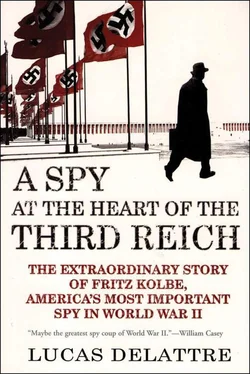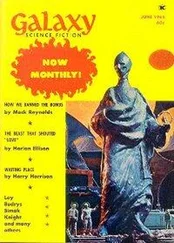And then there was an astonishing document dated December 24, 1943: a list of thirty-five prominent French personalities that the Gestapo proposed to have arrested, although it had not been able to reach its goal, “the various German authorities not having succeeded in coming to an agreement” on those arrests. As a consequence, Otto Abetz decided to send the list to Berlin in order to get definitive instructions from his ministry. The list, presented in alphabetical order, contained no names of political figures, except for that of a former minister, Lucien Lamoureux, characterized as an “active radical-socialist” but defended by the German military authorities against the Gestapo. Principally targeted were the mayors of a certain number of French towns characterized as “opponents of collaboration,” “pro-Jewish Gaullists,” “Freemasons,” or even “members of the Rotary Club.” The mayors of Caen, Rennes, Rouen, Poitiers, Abbeville, Lunéville, Versailles, Fontainebleau, Chartres, Pontivy, and even Vichy were suspected. There were also some prefects (Alpes-Maritimes, Hérault, Calvados). But in every case Ambassador Abetz or the military occupation authorities pointed out that there was no evidence of an offense and refused to authorize the arrests. There were also important figures from the world of finance, such as Henri Ardant, the influential president of the Société Générale (the Gestapo denounced his “anti-German attitude,” but the military authorities defended him) and Yves Bréart de Boisanger, governor of the Bank of France (called “disloyal” by the Gestapo, but Hans-Richard Hemmen, the Reich’s delegate for economic and financial questions to the French authorities, opposed his arrest. There were also several actors: Jean-Louis Barrault, Marie Bell, Béatrice Bretty (“the embassy expresses reservations, because they are politically insignificant; very much appreciated as artists”), and personalities of the intellectual world like the publisher Jean Fayard, whom the embassy defended because he had “published books favorable to National Socialism before the war.” In the end, the composition of this “blacklist” had no consequences. The weakness of the accusations, the competition among the different occupation authorities, and the complexity of the protective networks were stronger than the Gestapo.
Bern/Berlin, early January 1944
Because of the holiday at the end of the year, Fritz had stayed an entire week in Bern. He returned to Berlin on Sunday, January 2. Later, speaking of this trip, he remembered that he had returned home in a state of advanced fatigue, “not at all rested or rejuvenated, but pale with exhaustion, having gone without sleep for several nights, and always a little nervous.” The last adjective is a euphemism: Every time he returned to Germany, Fritz was terrified at the idea of being picked up by the Gestapo when he got off the train. But this time again, he could return home as though nothing had happened.
In Bern, the Americans were staggering under the workload. Every night between Christmas and New Year’s Day had been spent talking with Kolbe. During the day, Allen Dulles and Gerald Mayer wrote summaries that they immediately turned over to their technical staff for coding. Dulles made several reports to Washington after each of his conversations with “Wood.” He used some general elements of analysis to supply material for his telephone conversations with Washington headquarters, which took place every evening in the form of news flashes. Cables went off day and night. On the basis of the “secret cables of the Reich” ( geheime Reichssachen ) brought by Fritz, the Kappa messages were developed for London and Washington. Once there, they would be reworked and summarized under the name of “Boston series.” As usual, the OSS Bern experts had to be particularly careful to disguise all proper names. Von Papen became Milit and Sükrü Saracoglu, the Turkish prime minister, Harem. Numan Menemencioglu, the foreign minister, was Penni. Otto Köcher, the German envoy to Bern, was called Lomax, and Switzerland was designated as Rasho. In the period from Christmas to the middle of January, OSS Bern was working at top speed. It took at least two weeks after every visit from Kolbe to digest all the documents that he had brought.
To get the materials from “George Wood” to London and Washington, the Americans had had access to a new means of communication since the fall of 1943. Of course, the telegraph remained the favored means of transmission—there was nothing faster or more secure. But since the liberation of Corsica in October, Allied troops were no longer very far from Switzerland, and OSS contacts in the Resistance made it possible to transmit documents through Geneva, Lyon, and Marseille to Calvi or Bastia. This system was useful for conveying copies of original documents or maps. Files were first microfilmed. Then the precious little package was given to a locomotive engineer on the train between Geneva and Lyon. The railroad man placed the package in a little hatch above the boiler, ready to destroy it quickly in case of an untimely visit from the Gestapo. In Lyon, a “friend” received the envelope and carried it to Marseille by bicycle. From there, a fishing boat took it to Corsica, where it was put on board a plane for Algiers, then on to London and Washington. Between the departure and the arrival of the package, ten to twelve days went by.
The quantity and quality of documents supplied by “George Wood” in the course of this Christmas visit considerably increased his credibility. Even before Fritz’s departure for Berlin, Allen Dulles had taken up his pen to sum up their third encounter: “I now firmly believe in his good faith and am ready to stake my reputation that they are genuine. I base my conclusion on internal evidence and on the nature of the documents themselves,” he wrote on December 29, 1943 to his usual correspondents in the OSS. In Washington as well, they were beginning to become convinced of the good faith of the Berlin agent. “Seemingly authentic and vastly more interesting,” was now the word in General Donovan’s entourage (telegram from Washington headquarters to the OSS London office, 7 January 1944).
On January 10, the head of the OSS decided to present the first fourteen Kappa/Boston cables to President Roosevelt. The file was extremely confidential, and its distribution correspondingly restricted: There was a copy for the White House, another for the State Department, one for the War Department, and one for the Navy. And then a few selected items were given to one or another department of the OSS, especially counterespionage (X-2), but also the research and analysis department. A few fragments were communicated to the army intelligence services (G2). In all, no more than about ten people were kept informed of the revelations from “George Wood.”
Berlin/Bern, February–March 1944
It was impossible for Fritz to return to Switzerland after his long stay at Christmas. Too many absences would have been noticed. To get around the difficulty, he approached a colleague who had had the good fortune, in early 1944, to be placed on a list of regular couriers for Bern. A member of the Nazi Party, Willy Pohle had all the requisite qualities for the position. But Fritz trusted him, knowing that he could give him his personal correspondence with no fear. Fritz even dared to tell him, as he had already confided in Fräulein von Heimerdinger, that he wished to inform certain “German émigré circles in Switzerland” about what was really going on in Germany. Willy Pohle willingly agreed to be of service to him. After all, this kind of small gesture was common in the ministry. Fritz was able to show his gratitude. He asked his colleague to go to see Walter Schuepp in person in Bern (Gryphenhübeliweg 19), to withdraw the sum of fifty Swiss francs “due from a friend” (not telling him, of course, that this was left over from the two hundred francs given to him by Dulles). Fritz suggested to Pohle that he use some of that money for his personal expenses and that he buy cigars with the rest, in order to be able to offer some to Karl Ritter.
Читать дальше











